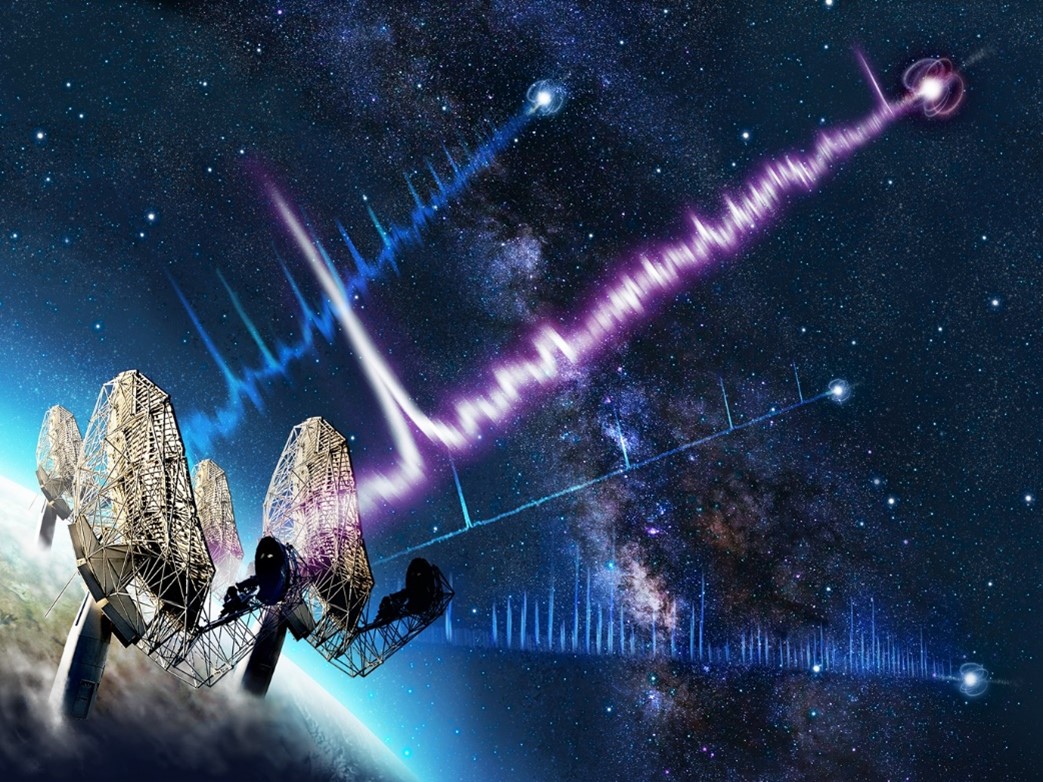The discovery of an ultra-long period neutron star, emitting unusual radio signals is rewriting our understanding of these unique star systems. The source has been found to reside in a neutron star graveyard and yet still produce radio emission (zombie stars!). It exhibits highly unusual and chaotic pulse shapes quite unlike anything seen in known neutron stars.
Neutron stars are extremely dense remnants of massive star explosions (supernova). They measure about 20 km in diameter and a teaspoon of neutron star material would weigh 4 billion tons on Earth. We currently know of about 3,000 of these in our own Galaxy. Neutron stars are typically born rapidly spinning and emit beams of radio waves from their magnetic poles. As they rotate, these beams of radiation appear as incredibly regular flashes, much like a cosmic lighthouse. Neutron stars come in a variety of flavours ranging from millisecond pulsars to the more recently discovered Ultra-Long Period Neutron Stars (ULPNSs). The exact mechanism of radio emission is still unknown. Until now, their spin periods ranged from about 1.4 milliseconds to 23.5 seconds. Our team of astronomers recently discovered PSR J0941-4046, an unusual radio emitting neutron star, which rotates extremely slowly, completing one rotation every 76 seconds. This is the slowest spinning neutron star yet discovered.
PSR J0901−4046 was a serendipitous single pulse discovery on 27 September 2020, in an observation conducted by the Meer(more) TRAnsients and Pulsars (MeerTRAP - https://www.meertrap.org/) and ThunderKAT (http://www.thunderkat.uct.ac.za) projects at the MeerKAT radio telescope in South Africa. We spotted a peculiar looking flash or ‘pulse’ lasting about 300 milliseconds. Though the pulse had some characteristics of a neutron star, it wasn’t like anything we had seen before. Intrigued, we scoured through older data of the same region of space in hopes of finding similar pulses. Interestingly, we identified more such pulses that our real-time pulse detection system missed as we typically only search for pulses that last a few tens of milliseconds. The pulse itself is typically only on for about 300 milliseconds of the 76-second rotation period of the pulsar. This means that it is very fortuitous that the radio beam intersected with the Earth, and that we detected it. PSR J0941-4046 is unique as it resides in the neutron star graveyard where we do not expect any radio emission at all. This challenges our understanding of how neutron stars are born and evolve.
The pulse morphology of PSR J0941-4046 is remarkable and unusual as it appears to contain at least 7 different pulse types. One type shows pulses that appear to be semi-periodic (aka quasi-periodic), which could be interpreted as seismic vibrations or crustal oscillations of the neutron star. These pulses could provide us with valuable information about the underlying physical mechanism. Presently, it is unclear what causes the observed quasi-periodicity. Interestingly, these quasi-periodic pulses also bear some resemblance to the morphology of the enigmatic fast radio bursts, which are short radio bursts of unknown origin. PSR J0941-4046 could be an ultra-long period magnetar - a star that possesses powerful magnetic field as its name suggest - which scientists theorize could be possible progenitors of fast radio bursts. However, whether PSR J0941-4046 emits pulses with energies like fast radio bursts is yet to be confirmed.
The radio energy produced by PSR J0941-4046 bears similarities to the extremely precise clocks in the sky that are pulsars, and the travel time of the pulses of PSR J0941-4046 to the Earth have been predicted to a precision of 100 millionth of a second. However, the chaotic components and the pulse polarization remind us of magnetars. Whether PSR J0941-4046 is a pulsar or magnetar is still an open question. The similarity in period to the radio pulsating white dwarf binary system AR Scopii, led us to search for potential counterparts in the optical part of the spectrum. Unlike neutron stars, white dwarfs are formed from the collapse of low mass stars. While the spin period of PSR J0901−4046 might be consistent with a white dwarf, we do not see any emission at other wavelengths like X-rays, optical and Gamma-rays to support this. The deepest image of the field shows a partially visible, diffuse shell-like structure surrounding PSR J0901−4046. This might be the supernova remnant from the event that formed the neutron star. Given the complexity of the field PSR J0941-4046 resides in, we need to conduct further investigations to confirm the characterization.
This significant discovery will potentially lay the foundation for the creation of a new class of radio neutron stars. Whether or how it relates to other known neutron stars is yet to be explored. It adds to the possibility of the existence of a new class of radio transients, the ultra-long period neutron stars, suggesting a possible connection to other classes of neutron stars and fast radio bursts. The fact that we have discovered one means that there are potentially many more out there. We just need to look!
Original Article:
Caleb, M., Heywood, I., Rajwade, K., Malenta, M., Willem Stappers, B., Barr, E., Chen, W., Morello, V., Sanidas, S., van den Eijnden, J., Kramer, M., Buckley, D., Brink, J., Motta, S. E., Woudt, P., Weltevrede, P., Jankowski, F., Surnis, M., Buchner, S., … Fender, R. (2022). Discovery of a radio-emitting neutron star with an ultra-long spin period of 76 s. Nature Astronomy, 6(7), 828–836. https://doi.org/10.1038/s41550-022-01688-x
 Earth & Space
Earth & Space



